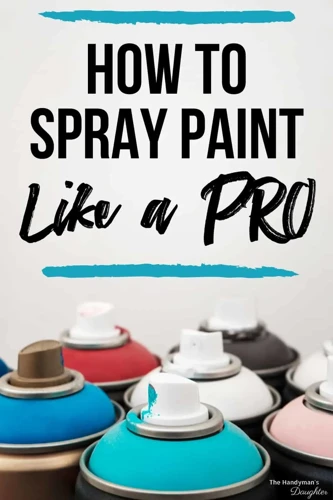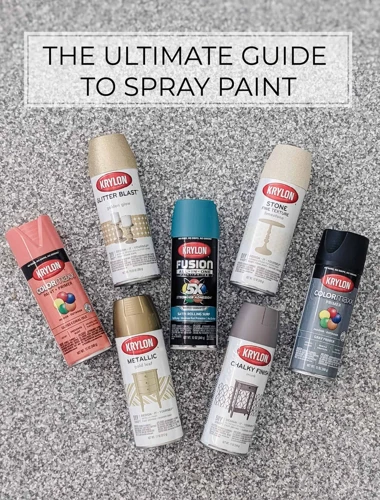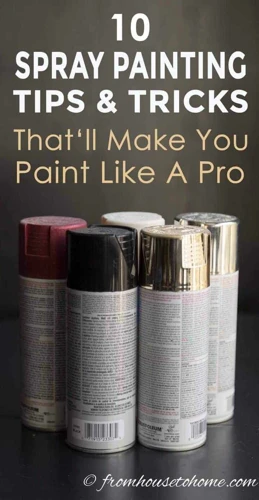Welcome to the colorful and creative world of DIY spray painting! Whether you’re looking to revamp a piece of furniture, add a splash of color to home decor, or create a stunning piece of art, mastering the art of spray painting can transform any project. With the right spray paint tips and a bit of practice, you’ll be able to achieve a professional finish that’s sure to impress.
Choosing the Best Spray Paint for Your Project
Selecting the best spray paint is crucial for the success of your project. It’s the cornerstone of professional spray painting and ensures that your efforts yield the most vibrant and long-lasting results.
Comparing Brands and Types of Spray Paint
Different brands offer unique qualities, so it’s important to compare them and find the one that best suits your needs. Consider factors like coverage, drying time, and color selection. Acrylic-based spray paints are great for most projects, while enamel spray paints are more durable and suited for outdoor items.
Understanding Spray Paint Finishes
Spray paint finishes can range from matte to high-gloss, each providing a distinct look and feel to your work. A matte finish will give you a flat, non-reflective surface, while a gloss finish will offer a shiny, vibrant appearance. Satin and semi-gloss options are available for those looking for a middle ground.
Preparation for Professional Spray Painting Results
The foundation of great spray painting lies in thorough preparation. Without it, even the best spray paint may not adhere properly or look as expected.
Cleaning and Priming the Surface
Start by cleaning the surface to remove any dust, grease, or rust. Once clean, applying a primer will ensure better paint adhesion and a uniform finish. This step is non-negotiable for professional spray painting results.
Setting Up Your Spray Painting Area
Create a well-ventilated space to work in, and protect surrounding areas with drop cloths or newspaper. Good lighting is essential to help you achieve even coverage and spot any missed areas.
Essential Spray Painting Techniques
Now that you’ve set the stage for success, let’s delve into the core spray painting techniques that will elevate your project.
Mastering the Spray Paint Motion
Develop a steady, consistent motion to apply the paint smoothly. Start spraying before the object and continue past it to avoid buildup at the edges. Maintain a consistent distance from the surface, typically around 10 to 12 inches.
Avoiding Common Spray Paint Application Mistakes
To prevent drips and uneven layers, apply multiple thin coats rather than one thick coat. Resist the urge to overcoat, as this can lead to runs and sags in the paint.
Advanced Spray Painting Techniques
With the basics down, you can explore advanced spray painting techniques to add depth and texture to your creations.
Creating Textures and Layers
Experiment with layering colors or using objects like lace or leaves to create patterns. Textured spray paints can also add a unique dimension to your projects.
Using Stencils and Masks in Spray Paint Art
Stencils and masking techniques allow for crisp lines and intricate designs. Use tape or paper to cover areas you want to protect from overspray, and then remove them to reveal your design.
Spray Paint Tutorials for Specific Projects
Each project may require a different approach. Luckily, there are many spray paint tutorials tailored to specific items.
DIY Spray Painting Furniture and Decor
Revitalize old furniture with a fresh coat of spray paint. Sanding the surface beforehand will help the paint stick, and using a sealant afterward will protect your hard work.
Unique Ideas for Spray Paint Art
Think beyond traditional surfaces and try spray painting on glass, metal, or even fabric. Explore different spray paint art techniques to create pieces that stand out.
Top Spray Paint Tips and Tricks for a Flawless Finish
For that impeccable, drip-free finish, it’s all about the little details and knowing a few handy spray paint tricks.
How to Achieve Even Coats and Avoid Drips
Shake the can well before use, and test the spray on a piece of cardboard to get a feel for the nozzle. Apply paint in a sweeping motion and remember — patience is key. Let each coat dry completely before applying the next one.
Quick Fixes for Common Spray Paint Problems
If you encounter a drip, wait for it to dry and then sand it down before applying more paint. For coverage issues, a second or third coat can often do the trick.
Maintaining Your Spray Paint Tools
Proper care of your spray paint tools extends their life and ensures they’re ready for your next project.
Cleaning Nozzles and Preventing Clogs
After use, turn the can upside down and spray until only clear gas comes out. This cleans the nozzle and prevents clogs. Soak stubborn nozzles in thinner if necessary.
Proper Storage of Spray Paint Cans
Store your spray paint cans in a cool, dry place, away from extreme temperatures. Keep them out of direct sunlight to prevent pressure buildup that could lead to bursting.
Whether you’re a seasoned artist or a DIY enthusiast, mastering the art of painting can transform your projects from good to great. For those interested in spray painting techniques, our article on the best spray paint tips is a must-read. But don’t stop there – enhance your painting knowledge even further with our guides on using paintbrushes effectively with paint brush tips, working with oil-based paints at oil-based paint tips, and adding vibrancy to your artwork with our color oil paint tips. Each article is packed with insights to help you elevate your painting skills.
Conclusion: Perfecting Your Spray Painting Skills
Mastering spray painting requires practice, but with these tips, techniques, and tutorials, you’re well on your way to achieving stunning results. Embrace the process and watch as your DIY spray painting projects evolve into vibrant works of art.



